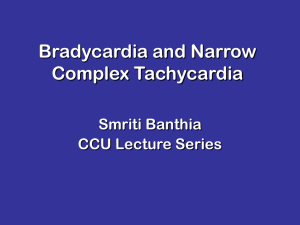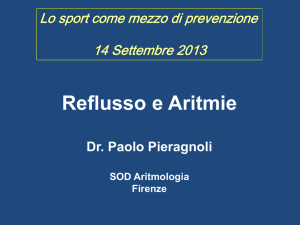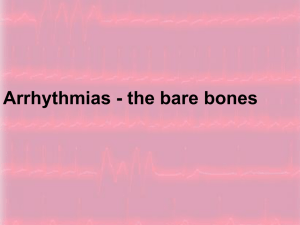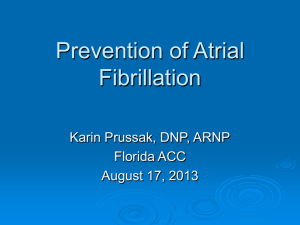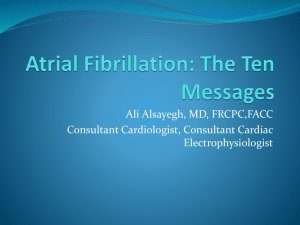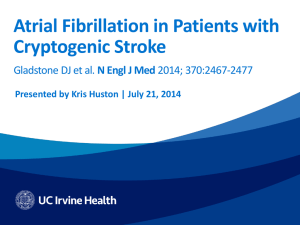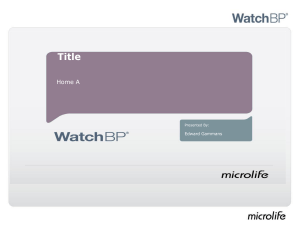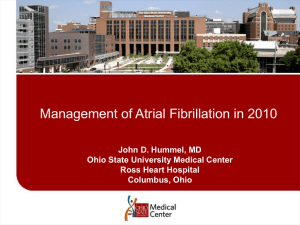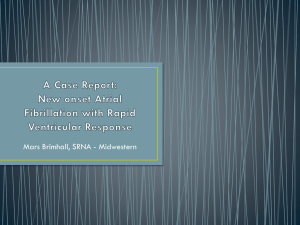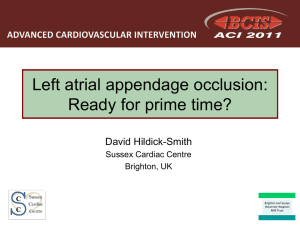Holly Everts, 2010. Atrial Fibrillation
advertisement
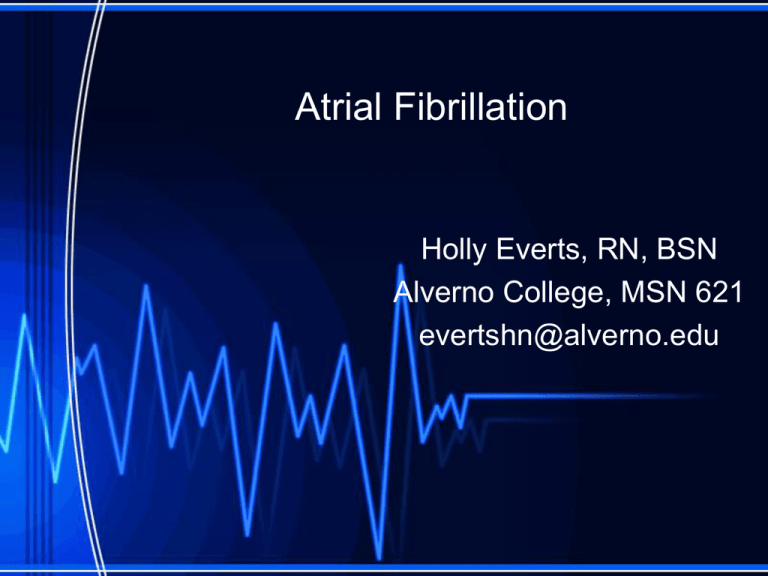
Atrial Fibrillation Holly Everts, RN, BSN Alverno College, MSN 621 evertshn@alverno.edu Tutorial Directions • Return to the table of contents by clicking the Table of button in the lower left corner. Contents • Navigate forward and backward using the buttons in the upper right corner. Table of Contents Learning Objectives • Define atrial fibrillation and be able to identify the rhythm. • Understand the pathophysiology of atrial fibrillation. • Discuss different causes of atrial fibriallation • Identify signs and symptoms of atrial fibrillation. • Describe various treatment modalities. • Identify nursing implications in caring for patients with atrial fibrillation. Table of Contents Table of Contents Table of Contents Normal Heart Function Definition of Atrial fib Electrical System Mechanical System Signs and Symptoms Aging processes and Atrial fib Procedures Medications Nursing Implications The Heart’s Mechanical System Your heart has 4 chambers ~left and right atria ~left and right ventricles The left and right sides of the heart are separated by a wall of muscles called the septum. Contractions The atria contract first and fill the ventricles. The ventricles contract shortly after and send blood to the lungs, heart and body. (Texas Heart Institute, 2009) Table of Contents Click for video American Heart Association, 2010 The Heart’s Electrical System ~Impulse originates in the sinoatrial (SA) node. ~Signal travels through specific pathways causing the atria to contract. ~Signal then moves to the atrioventricular (AV) node and the impulse slows. ~Signal leaves the AV node and travels along a pathway called the bundle of His and into the purkinje fibers. (National Heart, Lung, and Blood Institute, 2009). Table of Contents Used with permission by EKG concepts, 2009 Normal EKG rhythm Atria depolarize on the p wave. Ventricles depolarize on QRS complex and atria repolarize. Ventricles repolarize on the t wave. (National Heart, Lung, and Blood Institute, 2009). P wave Table of Contents QRS complex T wave Used with permission by EKG concepts, 2009 Quick Review Click where the electrical impulse originates in a normal sinus rhythm. Click on what is repolarizing during the QRS complex? Correct!! Atria Table of Contents Incorrect Ventricles Used with permission by EKG concepts, 2009 Case Study • Mrs. B comes to the emergency room complaining of feeling weak, short of breath, light headedness, palpitations and mild chest discomfort. • She is 87 years old with a history of smoking, hypertension, coronary artery disease and anxiety. • You attach her to the EKG and the physician gives her the diagnosis of atrial fibrillation. Table of Contents • What is atrial fibrillation? What is Atrial Fibrillation? “Atrial Fibrillation is an arrhythmia characterized by chaotic impulses propagating in different directions and causing disorganized atrial depolarization without effective atrial contraction” (Porth, 2005, p. 592). The ventricular rate is irregular and can be fast or slow. Click for video Table of Contents American Heart Association, 2010 (Porth, 2005) Pathology of the Electrical System • In Atrial Fib, the heart's electrical signals do not begin in the SA node. – Impulses start in other parts of atria – Impulses can begin in pulmonary veins • Signal is disorganized • AV node is flooded with impulses • Ventricles react with a tachycardic rate (National Heart, Lung, and Blood Institute, 2009). Table of Contents EKG in Atrial Fibrillation Notice there are no defined “p” waves or “t” waves but fibrillatory waves are present instead. Click for video The ventricular rate is irregular American Heart Association, 2010 Fibrillation waves Table of Contents Irregular QRS Used with permission from P. Schwartz Review Question • Mrs. B is feeling palpitations due to her rapid heart rate. How is atrial fib causing her rate to be so fast (click on answer)? Rapid impulses released by SA Incorrect, node. try again. Table of Contents Rapid impulses released by the ventricles. Incorrect, try again. Rapid impulses released by multiple Correct!!locations in the atria Rapid impulses released by AV node. Incorrect, try again. Pathology of the Mechanical System • In Atrial Fib, blood pools in the atria and is not pumped completely into the ventricles. – (National Heart, Lung, and Blood Institute, 2009). • The heart's upper and lower chambers do not work together as they should. – (National Heart, Lung, and Blood Institute, 2009). • Amount of blood pumped out to the body is random. – (National Heart, Lung, and Blood Institute, 2009). • Stroke volume different with every beat and cardiac output is decreased. – (Porth, 2005). Table of Contents Signs and Symptoms of Atrial Fibrillation Symptoms vary greatly among individuals and include: Palpitations Shortness of Breath Irregular heart rate Fatigue/weakness Pulmonary edema Dizziness Chest pain Risk for stroke (Porth, 2005) Table of Contents Review Question • Which of Mrs. B’s symptoms are due to decreased cardiac output caused by her atrial fibrillation? Yes! Cardiac demand Chest is greater than output discomfort causing chest pain Yes! Due to decreased perfusion Weakness to muscles Yes! Due to Shortness of decreased Breath perfusion to lungs This would be Palpitations caused by excited cells in atria Yes! Due to Dizziness decreased cerebral perfusion Table of Contents Cardiac cells and Ions Sodium and Calcium enter the cell during depolarization. Ca++ Na+ Cell K+ Potassium leaves the cell slowly during depolarization and quickly during repolarization. Cell during depolarization Table of Contents (Porth, 2005) Cardiac Cycle and Ions • During atrial fibrillation, calcium ions build up in cells that cause calcium overload. – High electrical activity makes it difficult for myocytes to remove calcium from the cells. • Calcium overload of the cell leads to electrical and mechanical remodeling. – Activates proteases that breakdown important cellular proteins. – This remodeling enlarges the atria making them more likely to sustain fibrillatory activity. Table of Contents (Cleveland Clinic, 2010) Review Question • During depolarization of a cell, which ions enter the cell? (Click the answers) Correct!! Calcium Correct Sodium Try again, potassium Potassium is already in the cell Try Chloride again Table of Contents Review Question • How does calcium overload in the cells remodel the myocytes (cardiac cells)? (Click the correct answer). Builds proteins that change the cells function.Try again Inhibits electricity to flow through the cell. Try again Table of Contents Does not allow vitamin D to enter the cell Try again Activates proteases that breakdown important cellular proteins. Correct!! Aging and Atrial Fibrillation • Mitochondria are extremely important for oxidative energy for cells. – In atrial fib, rapid depolarization leads to higher demand for energy and oxygen consumption. • As cells age, mutations of mitochondrial DNA (mtDNA 4977) accumulate. – Result – dysfunctional mitochondria • Impaired oxidative energy production • Impaired electron transport in metabolism and accumulation of free radicals. Table of Contents – (Lai, L., Tsai, C., Su, M., Lin, J., Chen, Y., Tseng, Y., Huang, S., 2003). Aging and Atrial Fibrillation • A study of 88 patients undergoing open heart surgery showed: – Pediatric and Adolescent patients did not have mutated DNA - mtDNA 4977. – Older patients had mtDNA 4977. – Patients with atrial fibrillation had a higher level of mtDNA 4977. • Conclusion – Age related changes and mutations are associated with atrial fibrillation. Table of Contents (Lai, L., Tsai, C., Su, M., Lin, J., Chen, Y., Tseng, Y., Huang, S., 2003). Etiologies: Stress and Atrial Fibrillation • Stress causes release of stress hormones • Norepinephrine – stress hormone – activates beta receptors and the renin/angiotensin/aldosterone system (Porth, 2005). – shortens the atrial action potential and recovery period (Otway, Fatkin & Vandenberg, 2007). • A number of potassium (K+) currents are highly responsive to adrenergic stimuli. – Shortens the refractory period. – (Otway, Fatkin & Vandenberg, 2007). Table of Contents Review Question • Mrs. B is cooking dinner tonight for her whole family and is stressed about seeing her sonin-law. She starts feeling frequent palpitations and short of breath. How might her age and stress contribute to her symptoms? Incorrect! is a Stress isStress a genetic normal response of the response that leads sympathetic nervous aging system (Porth, 2005). Table of Contents Age can cause genetic mutations that lead to atrial dysfunction and make Correct! cells more vulnerable to stress hormones Etiologies: Inflammation and Atrial Fib • C-reactive protein correlates to atrial fibrillation duration. – proves association between inflammation and atrial remodelling. • C-reactive protein values have been found to decrease post-cardioversion. • White blood cell (WBC) count has been found to lower the seventh day post-cardioversion. (Korantzopoulos, P., Kolettis, T., Siogas, K., Goudevenos, J., 2005). Table of Contents Etiologies: Reactive Oxygen Species (Free Radicals) • Review: • Dysfunctional mitochondria in aged cells impair electron transport in metabolism. – Leads to accumulation of free radicals – Free radicals damage cellular components and tissues. – Oxidative stress increases the amount of mtDNA 4977. – (Lai, L., Tsai, C., Su, M., Lin, J., Chen, Y., Tseng, Y., Huang, S., 2003). Table of Contents Etiologies: Reactive Oxygen Species (Free Radicals) • Calcium and reactive oxygen species • Calcium overload can cause increase nitric oxide (NO) levels. – Nitric oxide has pro-oxidative and antioxidative effects (Cleveland Clinic, 2010). – The toxicity of NO depends on what molecule it reacts with (Aikio, Poleka, & Hallman, 2002). – Reaction of NO and O2- lead to pro-oxidative damage and the destruction of cellular proteins and DNA (Aikio, Poleka, & Hallman, 2002). Table of Contents Etiologies: Reactive Oxygen Species (Free Radicals) • Atrial fib and neurohormonal activation. – Leads to increased release of Angiotensin II and superoxide (O2- ). (Cleveland Clinic, 2010). • A study done in the UK measured the amount of vascular superoxide from tissue samples of 79 patients. • Patients that were prescribed medication to block angiotensin II showed a significant decrease in vascular superoxide levels. – (Berry, C., Anderson, N., Kirk, A., Dominiczak, A., & McMurray, J., 2001). Table of Contents Review Question • How would Mrs. B’s stress of cooking dinner for everyone increase her free radical production? (Click on the correct answer) Stress neurohormones increase angiotensin 2 and superoxide levels. Correct!! Table of Contents Stress releases calcium from the cells causing increased nitric Incorrect, oxide. remember too much calcium in the cell releases nitric oxide Etiologies: Genetics and Atrial Fibrillation • The Mayo Clinic identified a mutation in DNA that was linked to atrial fibrillation. • Gene KCNA5 produces an important heart protein Kv1.5. – Kv1.5 is an important protein involved with ion channels • A mutation in this gene caused a loss of function in this protein. • This loss of function made the atria susceptible to sustain atrial fibrillation. – (Olson, T., Alekseev, A., Liu. X., Park, S., Zingman, L., Bienengraeber, M., Sattiraju, S, Ballew, J., Jahangir, A., & Terzic, A. 2006). Table of Contents Review Question • How does norepinephrine effect atrial fibrillation? (click on the correct answers) Stimulates beta receptorsCorrect!! Causes gene mutation Incorrect Table of Contents Slows HeartIncorrect Rate Increases responsiveness of Correct!! potassium channels Review Question • Free radicals, (such as nitric oxide and superoxide) contribute to atrial fibrillation by breaking down proteins and damaging DNA. True Correct!! Table of Contents False Incorrect Treatment Options Several approaches are used to treat and prevent atrial fibrillation: Ablation MAZE procedure Table of Contents Cardioversion Medications Procedures: Ablation • A catheter is inserted into the femoral artery to the area of heart muscle where there's an accessory (extra) pathway. • The catheter is guided using fluoroscopy. • The physician is able to see the exact area on the heart that is causing the accessory pathway • Radiofrequency energy is transmitted to the pathway and destroys the selected heart muscle cells in a very small area (about 1/5 of an inch). (American Heart Association, 2010). Table of Contents Procedures for Atrial Fibrillation Cardioversion Electrode patches are placed on the front and back of the chest and connected to the defibrillator. The defibrillator is then synchronized to deliver a shock on the QRS complex. This shock interrupts all electrical activity of the heart and allows the normal heart rhythm to return. – (Kang, 2010). Table of Contents Procedures for Atrial fibrillation • MAZE procedure • Incisions are made in the atria creating scar tissue that electrical impulses can not travel through. • This redirects the hearts electrical pathway and eliminates accessory pathways. • “The Maze procedure has been very successful with a 98% success rate in "lone atrial fibrillation" patients and a 90% success rate overall. Post – Maze procedure freedom from stroke has been over 99%.” » (Cleveland Clinic, 2010) Table of Contents Medications to treat Atrial Fibrillation • Anti-arrhythmic medication classes Ca++ – Sodium channel blocker • Multaq – Beta Blockers Na+ • Metoprolol – Potassium Channel blocker Cell • Sotalol, Amiodarone, Tikosyn – Calcium Channel blocker • Cardizem – Other mechanisms • Digoxin, Adenosine Table of Contents How do they work? K+ Medications: Rate Control • Calcium-channel blockers: slow the influx of calcium ions into the heart and slow the depolarization and repolarization periods (Lehne, 2004). • Beta-blockers: "block" the action of sympathetic neurotransmitters on beta receptors. – This slows down conduction of impulses through the heart and make the AV Node less sensitive. • Digoxin: slows down the heart rate by blocking the electrical conduction between the atria and ventricles. • (Ryan, 2002) Table of Contents Rhythm Control • Sodium Channel Blockers which decrease the speed of electrical conduction in the heart muscle and stabilize cell membranes. • Potassium Channel Blockers slow nerve impulses in the heart, keep the cell depolarized longer and stabilize cell membranes. – (Ryan, 2002) Conversion of atrial fibrillation Agents with proven efficacy: dofetilide, amiodarone, ibutilide, flecainide, propafenone, and quinidine. Less effective or incompletely studied agents: procainamide, sotalol, and digoxin. Table of Contents (Borczuk, 2009) Review Question • Why would Mrs. B’s potassium channel blocker, such as amiodarone, be used for rate and rhythm control? Table of Contents Potassium channel blockers slow the rate of conduction by slowing the efflux of potassium Potassium channel blockers deplete the cells of potassium therefore inhibiting depolarization. Correct! Incorrect Nursing Implications • Monitor hemodynamic stability – Heart rate, blood pressure, oxygenation & perfusion • Symptom control – Anxiety, shortness of breath, dizziness • Activity intolerance • Medication management • Monitor for complications – Blood clot formation – PE, stroke, MI, DVT Table of Contents Nursing Diagnoses and Outcomes Activity Intolerance Decreased cardiac output 0400 Cardiac Pump Patient is able to eject Effectiveness enough blood to support (Moorhead al, 2004). systemic et circulation. Decreased Cardiac Output Ineffective Perfusion Table of Contents Patient is able to conserve 3011 Activity Tolerance energy and build endurance et al, 2004). to(Moorhead complete activities of daily living. Decreased cardiac output 0401 Circulation Status Patient is able perfuse (Moorhead al, 2004). tissues andetmaintain an appropriate blood pressure. Click on nursing diagnosis for correlating nursing outcome. Then click on the nursing outcome for further explanation. Nursing Diagnoses and Outcomes Ineffective Coping Risk for Falls Table of Contents Fear and anxiety Patient is able to utilize 1402 Anxiety Self-Control actions to reduce stress, (Moorhead et al, 2004). tension and apprehension. Decreased cardiac output Patient is able ask for help 0406 Tissuerisk Perfusion: and reduce factors for Cerebral falls. Patient has adequate (Moorhead et al, 2004). cerebral perfusion to prevent falls. Click on nursing diagnosis for correlating nursing outcome. Then click on the nursing outcome for further explanation. Conclusion • Atrial fib is the most common arrhythmia with 2 million Americans afflicted. • Atrial fibrillation is responsible for 15 to 20 percent of ischemic strokes. • By 2050, the CDC estimates that 12 million Americans will have atrial fibrillation. (Centers for Disease Control and Prevention, 2010) Table of Contents References • Aikio O, Pokela ML, Hallman M (2002). Pulmonary nitric oxide in preterm and term infants with respiratory failure Retrieved from, http://herkules.oulu.fi/isbn9514268512/html/i231674.html • American Heart Association. (2010). Atrial fibrillation. Retrieved from http://www.americanheart.org/presenter.jhtml?identifier=4451. • American Heart Association. (2008). Atrial Fibrillation for professionals. Retrieved from http://www.americanheart.org • Berry, C., Anderson, N., Kirk, A., Dominiczak, A., & McMurray, J. (2001). Renin angiotensin system inhibition is associated with reduced free radical concentrations in arteries of patients with coronary heart disease. Heart. 86(217-220). • Borczuk, P. (2009). Atrial fibrillation. Emedicine. Retrieved from http://emedicine.medscape.com/article/757370-overview. • Centers for Disease Control and Prevention. (2010). Atrial fibrillation fact sheet. Retrieved from Table of http://www.cdc.gov/dhdsp/library/fs_atrial_fibrillation.htm Contents References Table of Contents • Cleveland Clinic. (2010). Mechanisms of atrial electrical remodeling. Retrieved from http://my.clevelandclinic.org/heart/atrial_fibrillation/afresearch.as px. • EKG Concepts. (2009). Rapid cardiac arrhythmia tool. EKG Concepts, LLC. • Kang, S. (2010). Cardioversion. American Accreditation HealthCare Commission. Retrieved from http://www.nlm.nih.gov/medlineplus/ency/article/007110.htm • Korantzopoulos, P., Kolettis, T., Siogas, K., Goudevenos, J., (2005). The emerging role of inflammation in atrial fibrillation and the potential of anti-inflammatory interventions. European Heart Journal. 26(20). • Lai, L., Tsai, C., Su, M., Lin, J., Chen, Y., Tseng, Y., & Huang, S., (2003). Atrial fibrillation is associated with accumulation of aging-related common type mitochondrial DNA deletion mutation in human atrial tissue. Chest. Feb;123(2):539-44. References Table of Contents • Lehne, R. (2004). Pharmacology for nursing care, 5th edition. Elsevier Saunders: Philadelphia. • Moorhead, S., Johnson, M., & Maas, M. (2004). Nursing Outcomes Classification (NOC) (3rd ed.). St. Louis, MO: Mosby. • National Heart, Lung, and Blood Institute. (2009). Understanding the Heart's Electrical System. Retrieved from http://www.nhlbi.nih.gov/health/dci/Diseases/arr/arr_whatis.html. • National Heart, Lung, and Blood Institute. (2009). Understanding the Electrical Problem in Atrial Fibrillation. Retrieved from http://www.nhlbi.nih.gov/health/dci/Diseases/af/af_what.html. • Olson, T., Alekseev, A., Liu. X., Park, S., Zingman, L., Bienengraeber, M., Sattiraju, S, Ballew, J., Jahangir, A., & Terzic, A. (2006). Kv1.5 channelopathy due to KCNA5 loss-offunction mutation causes human atrial fibrillation. Human Molecular Genetics. 15(14). • Otway, R., Fatkin, D., & Vandenberg, J., (2007). Genes and atrial fibrillation. Circulation. 116(7). • Porth, C. (2005). Pathophysiology, 7th edition. Lippincott. References • Ryan, S. (2002). Atrial fibrillation: resource for patients. Retrieved from http://www.a-fib.com/Medications.htm. • Texas Heart Institute. (2010). Health Information Center. Retrieved from http://www.texasheartinstitute.org/HIC/Anatomy/anatomy2.cfm Table of Contents
